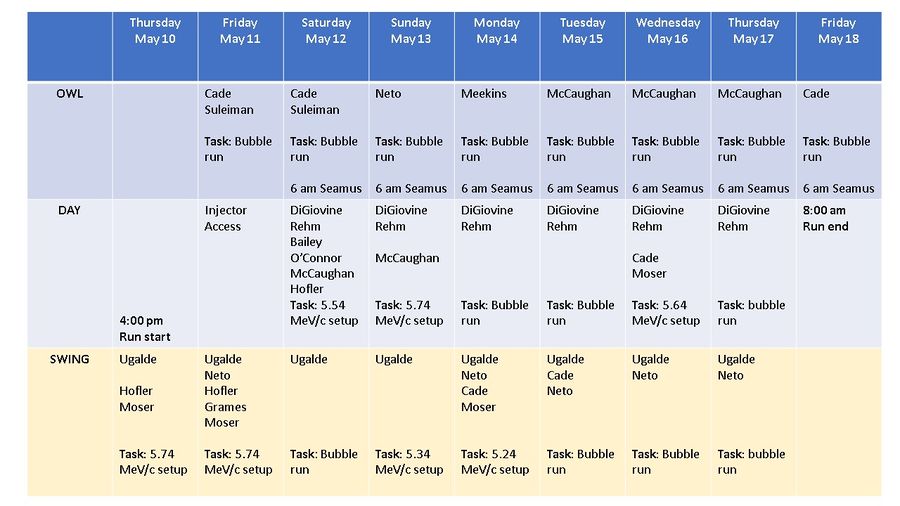Bubble Chamber Beam Test May 2018
Jump to navigation
Jump to search
Beam Setup and Measurement - May 2018
Bubble Chamber Turn On
- Fill with natural C3F8 – test bubble chamber systems operation
- Thresholds code for C3F8: media:ThresholdsC3F8.xlsx
- With beam on bubble chamber radiator:
- How does CCD camera perform under beam-on conditions?
- Count rates on bubble chamber. Do we get single or multiple bubbles from Bremsstrahlung beam exposure?
- Measure gamma ray beam spatial profile as reflected by bubble distribution. Is collimator effective in defining the gamma-ray beam?
- Test the bubble chamber laser shutter (gumby shutter)
- Background measurements:
- Measure beam off environmental background in chamber-injector area
- Measure beam on background by looking outside fiducial volume
- Measure background with beam to Faraday Cup in CEBAF beamline (about two meters from chamber)
- Measure neutron events in chamber. Neutron radiation detectors in injector region will indicate if any neutrons are generated
Bubble Chamber Beam Test
- Bubble Chamber Run Plan
- Draft Run Plan: media:bubble_runplan.pdf
- Systematics: media:bubble_systematics_May2018.pdf
- Joe's Dispersive and Non-Dispersive Optics for last week's beam study data
Run Plan:
- Prebeam Checkout:
- Neutron source test at 0.7, 1, 2, 5m
- Establish background rate with no beam
- Check if Bubble Chamber is working properly:
- Establish high rate checkout beam: 5.74 MeV/c, 1uA (1 event per 5s)
- Determine the initial operational pressure and temperature
- Establish fiducial region for beam
- Measure activity with beam in high pressure
- Move beam +/-3 mm and search for 10% lower rate
- Change spot size to 2, 3mm; observe 30% lower rate at 3mm
- Current scan: 0.5 uA for 1 hour, 0.25 uA for 2 hours
- Normalized yields should be identical
- Run high energy to low energy:
| Beam Momentum (MeV/c) | Beam Kinetic Energy (MeV) | Beam Current (µA) | Time (hour) |
| 5.24 | 4.75 | 50 | 31 |
| 5.34 | 4.85 | 50 | 40 |
| 5.44 | 4.95 | 20 | 13 |
| 5.54 | 5.05 | 10 | 6 |
| 5.64 | 5.15 | 4 | 3 |
| 5.74 | 5.25 | 1 | 3 |
Shift Schedule
media:ShiftSchedule_Bubble_May2018.pdf media:ShiftSchedule_Bubble_May2018.pdf
Nominal Daily Plan
| Thurday, May 10 | |
|---|---|
| Swing | p = 5.74 MeV/c, T = 5.25 MeV |
| Establish beam in the injector |
| Friday, May 11 | |
|---|---|
| Owl | p = 5.74 MeV/c, T = 5.25 MeV |
| Start commissioning plan | |
| Day | No beam |
| Swing | p = 5.74 MeV/c, T = 5.25 MeV |
| Continue commissioning plan Data for T = 5.25 MeV point |
| Saturday, May 12 | |
|---|---|
| Owl | p = 5.74 MeV/c, T = 5.25 MeV |
| Day | p = 5.64 MeV/c, T = 5.15 MeV |
| 3+ hours for this point | |
| Swing | p = 5.64 MeV/c, T = 5.15 MeV |
| Set up for p = 5.24 MeV/c, T = 4.75 MeV when previous point done | |
| 5.24 will be used to test if rates can be determined |
| Sunday, May 13 | |
|---|---|
| Owl | p = 5.24 MeV/c, T = 4.75 MeV |
| Day | p = 5.54 MeV/c, T = 5.05 MeV |
| Call Mom | |
| 6 hours data | |
| Swing | p = 5.44 MeV/c, T = 4.95 MeV |
| 16 hours data |
| Monday, May 14 | |
|---|---|
| Owl | p = 5.44 MeV/c, T = 4.95 MeV |
| Day | p = 5.44 MeV/c, T = 4.95 MeV |
| Swing | p = 5.34 MeV/c, T = 4.85 MeV |
| 48+ hours |
| Tuesday, May 15 | |
|---|---|
| Owl | p = 5.34 MeV/c, T = 4.85 MeV |
| Day | p = 5.34 MeV/c, T = 4.85 MeV |
| Swing | p = 5.34 MeV/c, T = 4.85 MeV |
| Wednesday, May 16 | |
|---|---|
| Owl | p = 5.34 MeV/c, T = 4.85 MeV |
| Day | p = 5.24 MeV/c, T = 4.75 MeV |
| 24+ hours | |
| Swing | p = 5.24 MeV/c, T = 4.75 MeV |
| Thursday, May 17 | |
|---|---|
| Owl | p = 5.24 MeV/c, T = 4.75 MeV |
| Day | p = 5.24 MeV/c, T = 4.75 MeV |
| Swing | p = 5.24 MeV/c, T = 4.75 MeV |
| Friday, May 18 | |
|---|---|
| Owl | p = 5.24 MeV/c, T = 4.75 MeV |
| Day | ~fin~ |
Presentations
- MCC 8 am presentation
